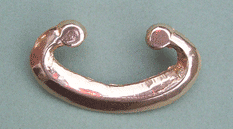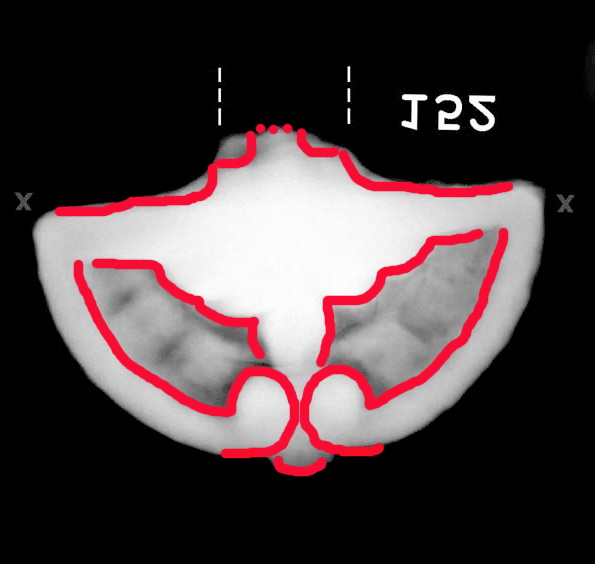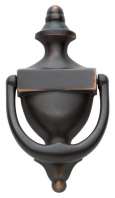Hello there,
As this seems to be the place to come for expert help on all things "swordy"...
I am involved in a History & Archaeology project, in Lincolnshire (East Midlands, England, for none UK residents)
A site we have been investigating has recently received a bit of local press attention, and as a result a local metal detectorist has kindly come forward with some items he had recovered over the years from fields adjacent to our site.
Amongst his collection where a couple of bits of fairly corroded Iron, and as we were already planning to get a couple of finds from the project X-rayed and still had some space, we included his bits as well in a spirit of “oh-why-not”.
The results were mixed but one gave the result shown below. The distance between the two X’s is roughly 73 mm; the object is a flat half circle with a single broken projecting arm or “tang” from the flat side. (Here indicated by the dashed lines).
The people who have looked over the assemblage so far have been stumped, but two or three have tentatively suggested a sword pommel in lieu of any better guess. The question is, does anyone here recognise it as that? Further more can anyone point me towards typologically similar pommels (Iron, half circles)
General gut feeling here is that it IS Medieval and has broken off something, and we would appreciate any help if we could cross pommel off the list or not.
Many thanks and I appreciate your time reading this.
Best wishes,
Pete
Edit: Sorry as I was typing, and took the measurement s from the finds description list. I was reading the wrong line, the distance is 73mm not 130 as previously stated.
[ Linked Image ]
Last edited by Peter L on Fri 18 Sep, 2009 7:06 am; edited 2 times in total
At more than 12 cm of width it's far too wide to be a pommel of a sword. Here's the Oakeshott's typology of the sword pommels:
http://www.myArmoury.com/feature_oakeshott3.html
I have no idea what it is, but at that size and shape it doesn't seem sword related.
http://www.myArmoury.com/feature_oakeshott3.html
I have no idea what it is, but at that size and shape it doesn't seem sword related.
Hello Peter.
I'm no expert but going by the shape, I'd guess... a tea cosy pommel, Petersen Type X? Maybe even the top half of a viking sword pommel.
Damn, I missed that part.
(Maybe it belonged to a giant? ;) )
I'm no expert but going by the shape, I'd guess... a tea cosy pommel, Petersen Type X? Maybe even the top half of a viking sword pommel.
| Blaz Berlec wrote: |
| At more than 12 cm of width it's far too wide to be a pommel of a sword. Here's the Oakeshott's typology of the sword pommels: |
Damn, I missed that part.
(Maybe it belonged to a giant? ;) )
Last edited by Anders Backlund on Fri 18 Sep, 2009 6:50 am; edited 1 time in total
At 130mm (5") across, it's far too large to be a sword pommel. How thick is the artifact? My first impression was that it might be purse hardware--either a weight or part of the suspension, or possibly both combined (?). The reproduction purse suspension bar shown below is 150mm across. The weight is smaller but will give you some idea of the shape If you were to position those roughly as they would be mounted, possibly including a wire frame, encased them in rust (if they were iron) and X-rayed them, you might see something similar to your artifact. If you turn your X-Ray upside down you can see how it might be interpreted as individual bits of purse hardware united by corrosion. Rust In Peace.
 Attachment: 5.69 KB
Attachment: 5.69 KB

 Attachment: 17.27 KB
Attachment: 17.27 KB



Here's what I'm seeing. Long arms reaching down with thicker scrolled terminals, almost touching. Another piece of the same material extends downward behind these terminals and protrudes below them. I can't tell if any of these projections are of a piece with the "crossbar" or joined to that bit in some way. There is some sort of patterned material enclosed by the arms. Thin stamped brass or iron? Heavy tooled leather?
 Attachment: 53.65 KB
Attachment: 53.65 KB


Last edited by Sean Flynt on Fri 18 Sep, 2009 7:13 am; edited 1 time in total
Blaz, Anders, Sean...
Sorry,(head in hands) I was typing far too quickly, I took the measurement off the line below. The distance between the two X's is 73mm and It is 25mm thick. The level of corrosion might mean this is a bit off by a few mm.
As I said before, it was simply the broken arm / bar / tang off the bottom that I belive lead people to the pommel conclusion, I am happy to accept it might just be one of those stray metal finds that never get a definitve identification.
Edit: Thanks for that Sean, I agree it is a possibilty. I will see if I can find anything comparable.
Cheers
Pete
Sorry,(head in hands) I was typing far too quickly, I took the measurement off the line below. The distance between the two X's is 73mm and It is 25mm thick. The level of corrosion might mean this is a bit off by a few mm.
As I said before, it was simply the broken arm / bar / tang off the bottom that I belive lead people to the pommel conclusion, I am happy to accept it might just be one of those stray metal finds that never get a definitve identification.
Edit: Thanks for that Sean, I agree it is a possibilty. I will see if I can find anything comparable.
Cheers
Pete
| Peter L wrote: |
| Blaz, Anders, Sean...
Sorry,(head in hands) I was typing far too quickly, I took the measurement off the line below. The distance between the two X's is 73mm and It is 25mm thick. The level of corrosion might mean this is a bit off by a few mm. As I said before, it was simply the broken arm / bar / tang off the bottom that I belive lead people to the pommel conclusion, I am happy to accept it might just be one of those stray metal finds that never get a definitve identification. Edit: Thanks for that Sean, I agree it is a possibilty. I will see if I can find anything comparable. Cheers Pete |
Hmm....given those dimensions it's less likely to be associated with a purse, I think. I still doubt it's a pommel. Too thin for a sword, too broad for a dagger. Decorative iron hinge, perhaps? If it were not so thick I'd say we're looking at an iron buckle from the back. The piece that protrudes beyond the arms (bottom of image) is the tongue. But it is quite thick....maybe enough of the thickness is corrosion that a buckle is still a possibility. Maybe some of our early Medieval folks here can tell us if there were such massive buckles. The broken-off bit could have been an escutcheon with a rivet for securing to a thick strap end. I'm officially stumped. :confused:
Here's a decidedly non-medieval guess. Makes perfect sense, construction-wise and in terms of dimensions. The light areas of the X-Ray would be the thin, hollow body of the knocker. The broken top would, indeed, be an escutcheon.
 Attachment: 3.3 KB
Attachment: 3.3 KB


I think it actually might be a sword pommel.
A width of 73 mm may at first seem to be too wide, but there are (early?) viking age hilt types with very wide pommels. A few rather exotic looking anglo saxon hilts have been found, that look more like something sprung out of a fairy tale than something with authentic historical provenance.
I would like to see more of the object before I would be willing to say that it might be a sword pommel.
The rust would hide most of the features, of course. Still some photos taken with slanting light may give an idea of overall shape and provide clues to more or less hidden features.
A width of 73 mm may at first seem to be too wide, but there are (early?) viking age hilt types with very wide pommels. A few rather exotic looking anglo saxon hilts have been found, that look more like something sprung out of a fairy tale than something with authentic historical provenance.
I would like to see more of the object before I would be willing to say that it might be a sword pommel.
The rust would hide most of the features, of course. Still some photos taken with slanting light may give an idea of overall shape and provide clues to more or less hidden features.
Size and shape-wise it might be a Viking / Anglo-Saxon period pommel, but I wonder:
- why the tang wouldn't show better on the X-ray (assuming a through tang peened at the end of the pommel)
- about the light shaded areas on the upper edge
- about the flare towards where the tang would be at the bottom
- why the tang wouldn't show better on the X-ray (assuming a through tang peened at the end of the pommel)
- about the light shaded areas on the upper edge
- about the flare towards where the tang would be at the bottom
Were those early pommels so thin (25mm)?
Wheres Peter Johnsson when you need him! I'm intrigued by this someone get peter to look at it!
| Sean Flynt wrote: |
| Were those early pommels so thin (25mm)? |
Yes, that is about right.
I would even say: often thinner.
These pommels can be really wide and rather thin.
There is an outrageous one on display at the British Museum (bronze, wing nut shaped with three or four dragon heads in cut through work on each side of a central hub). Strangely I could not find it in my photos. I know its been up for discussion here on the forum a few years back: under the theme of historically accurate fantasy...
| Peter Johnsson wrote: | ||
Yes, that is about right. I would even say: often thinner. These pommels can be really wide and rather thin. There is an outrageous one on display at the British Museum (bronze, wing nut shaped with three or four dragon heads in cut through work on each side of a central hub). Strangely I could not find it in my photos. I know its been up for discussion here on the forum a few years back: under the theme of historically accurate fantasy... |
Is this the one you're referring to Peter?
Thanks,
Dan
[ Linked Image ]
Thanks Dan!
The reason I thought of this one is that it illustrates how relatively free the expression of shape was at this time. The pommel loosely follows the established forms, but use them in a unique and creative way.
The mystery find in this thread might be another personal interpretation of the general pommel shape of the time. I also think I can make out something that could be cut out work in the shading of the X-ray?
More photos and information would be very interesting to see!
The reason I thought of this one is that it illustrates how relatively free the expression of shape was at this time. The pommel loosely follows the established forms, but use them in a unique and creative way.
The mystery find in this thread might be another personal interpretation of the general pommel shape of the time. I also think I can make out something that could be cut out work in the shading of the X-ray?
More photos and information would be very interesting to see!
Page 1 of 1
You cannot post new topics in this forumYou cannot reply to topics in this forum
You cannot edit your posts in this forum
You cannot delete your posts in this forum
You cannot vote in polls in this forum
You cannot attach files in this forum
You can download files in this forum
All contents © Copyright 2003-2006 myArmoury.com — All rights reserved
Discussion forums powered by phpBB © The phpBB Group
Switch to the Full-featured Version of the forum
Discussion forums powered by phpBB © The phpBB Group
Switch to the Full-featured Version of the forum